andrew carnie
| home page | introduction | art works | a few words | research | recent work |
books containing writing on the peices.
interview on the work by Jack Chuter
SciArt in America A conversation with Andrew Carnie by Danielle McCloskey Nov 2013
1. You have been a science-based artist for quite some time. How has the experience been? How does it feel now that more Sciartists are emerging?
I think I started making work on the fringes of science and art, art and science back as early as 1994-95, a series of paintings like Wiggle and Wind, and Open Heart resulted and photographs like Twins; is it really that long ago, yes nearly 20 years or so. I started using biological material, ideas and images from undertaking a zoology course at Durham University in the late 1970's. Terminology like sciart came later and I am not sure of the term sciart. I am not sure why the sci bit comes first? I am interested though in work involving ideas and imagery from science, I make work-using science. The art aspect is paramount, I don't illustrate science, science is not my only source of ideas and I don't want to feel at the 'beck and call' of science. I want to deal with interesting ideas and make 'good' work. I am an artist using science.
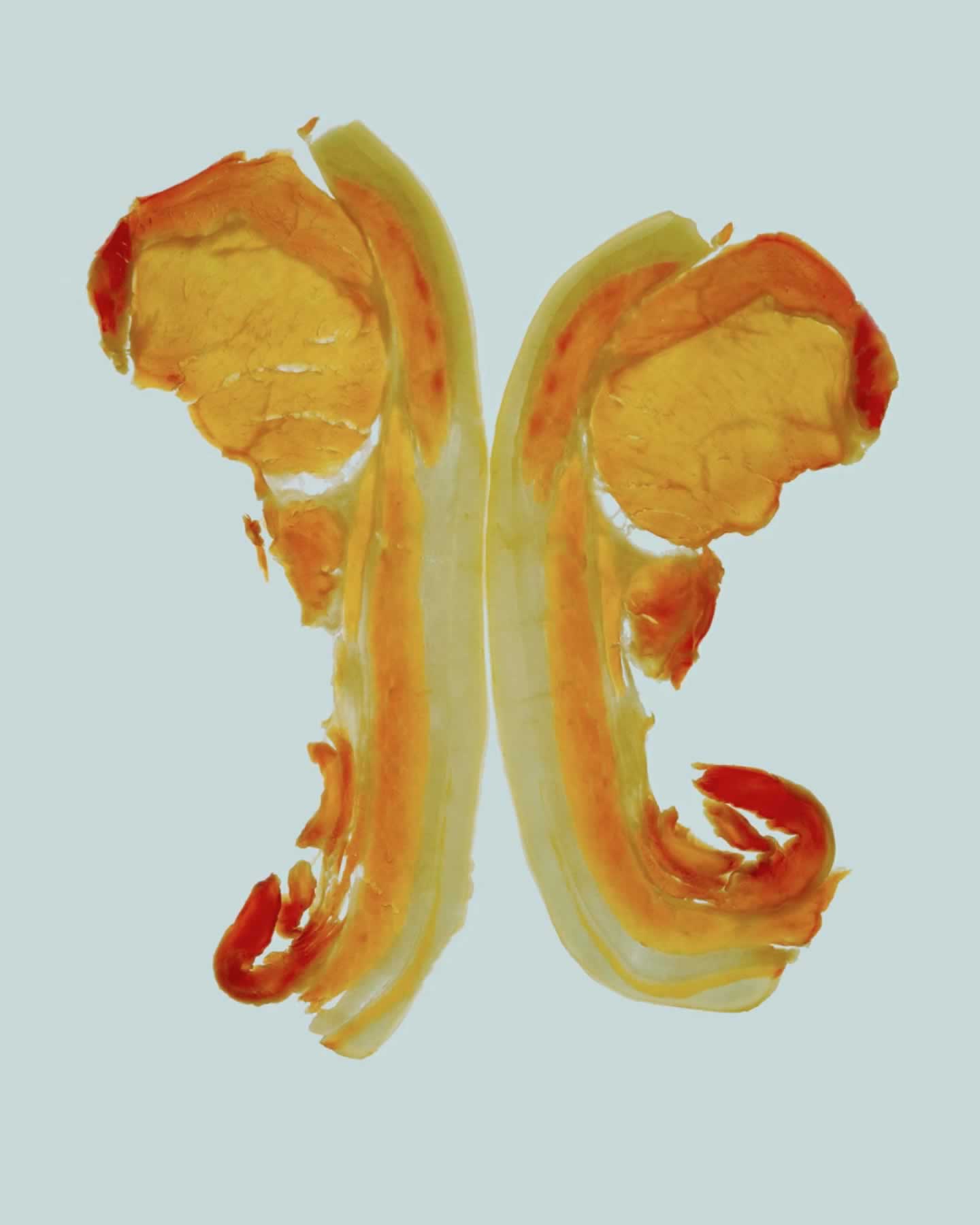 '
'
Twins' 1994. Image courtesy of the artist and GV Art gallery, London
The whole period has been a very interesting process, pleasing but very tough, as is the way in the arts. I have made good work I think consistently since the mid 1980's and maybe before with little recognition. Some of the work is being shown Internationally now, which is great. I think the sciart collaborative work really hasn't hit the mainstream art gallery and museum world even now, but there is a fair amount of support in various circles. My aim is to try and make good work that has an effect on audience, is meaningful and that satisfies me; if it doesn't hit the main stream that is OK.
The uptake now amongst younger artists is very interesting, it does seem to be growing as a concept, for me it will probably get a little more difficult to stand out in the area, get grants and shows, there is more competition! I guess too through this period I have had a feeling that one is forging a newish methodology of working and there is a bit of a positive feeling of being an outsider. I guess I would also say that my work is not completely dependent on being called sciart and understood in this way; I hopefully make interesting work that would stand up for itself in any situation, even outside a sciart context. I believe you don't have to understand my work from a scientific point of view to get involved in it. I have always made other types of work anyhow and I certainly hope the work I make will move on whatever area it is in.
What is good though over the last couple of decades is that the visual arts seem to have found a place, a higher profile, with more public involvement; Grayson Perry is giving the Reith Lectures this year in the UK; first for a visual artist to do this! I was educated at Goldsmiths in a period when everything was rather reductive, minimal and with a content that was about the language of art itself. I leant a lot of important matters in this period; but this kind of introspection lost a wider audience and led to a very bleak period for fine art in the public's eyes. I think work needs 'content' and it should not just be solipsistic, though if that is what some artists want that is fine.
For me I want conversations, I want to be part of a community; I believe this is very important. The content I get then is from science but it could be any subject. I tell my students I would be fascinated making work around competition leek growing in Wales and I would. For that matter I think carnival arts are very important, events like the Notting Hill Carnival in London, the Caribbean Carnival. It pulls creativity into the whole community and everyone is involved. I believe the role of artists is massively underutilized. I think artists should be everywhere, the glue sticking stuff together a bit like glial cells in the brain; making everything work, animating matters.
So I think it is great if we find places for artists to operate in and communicate with, to raise questions and hopefully to make good work within science settings.
2. What made you start making science based artwork in the first place?
I remember a talk by Francis Crick, discoverer with James Watson of the structure of DNA, who was brought into Goldsmiths by Saraht Mahraj, now Professor of Visual Arts and Knowledge Systems at Lund University in Sweden in about 1981 or '82. This was an important event and a marker, way before I started doing art science work, but I think the notion that there could be subjects we could look at outside art became important at this stage. I think this idea was fostered then only to become significant 10 years later.
I fell into making work in this area independently, I felt I was too submerged in my sculptural work and that I needed to try something else. I was actually being told I was too addicted to suitcases, the material I was then using to make work. I bought a 5 x 4 camera to take images of work but increasingly started to photograph biological items on a light box. Then it was due to the selection to participate in the show Head On in 2002 and its relative success that confirmed the full shift into the art science arena. Marina Wallace came to the studio, she was an old friend and really coming to look at the sculpture work I had been doing and was sort of known for. But she found some of the science art pieces I had been doing, leant against the wall and then told me about the project she was undertaking at the Science Museum, London with Ken Arnold, head of the sciart program at Wellcome Trust, Caterina Albano a curator with Marina at Central St Martins Art School and Prof Martin Kemp from Oxford University. I was selected to be in Head On, on the basis of the photographs and the knowledge that I had undertaken some science study earlier. Head On was the first in a series of art exhibitions exploring the relationship between art and science housed in the new Wellcome Trust Gallery at the Science Museum. This exhibition explored ideas about the brain through visual art. The process of making work for Head On gave me links with scientists like Richard Wingate, Colin Blakemore, Andrew Lumsden, and Colin Stolkin amongst others and all moved forward.
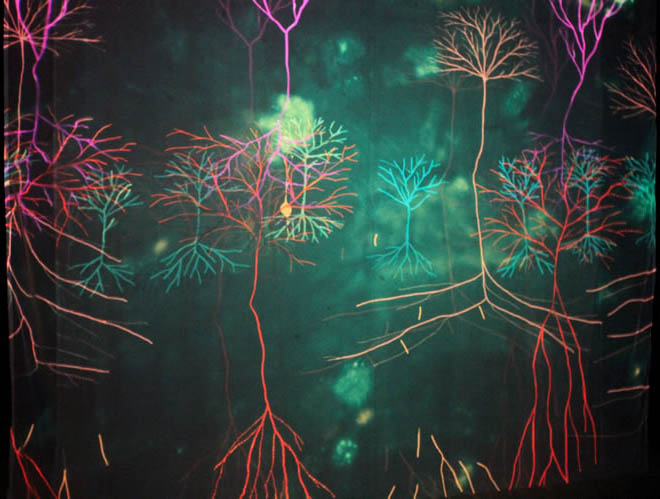
'Magic Forest' 2002. Image courtesy of the artist and GV Art gallery, London
I made the piece Magic Forest which worked well in the Science Museum and then a succession of other works followed like Complex Brain: Spreading Arbor also funded with a grant from the Wellcome Trust; a work also based around neurology.
3. You often take viewers on a "time-based journey" with your projections. Could you explain your ideas behind this and how they further the message in your pieces?
I had a fascination with projection when I was very much younger and involved in the natural sciences. I was a keen walker and avidly involved in the countryside when young, always outside. I got involved in making presentations about my interests and always wanted a Kodak Carousel projector. I never could afford one but now have 30, courtesy of mainly eBay! I still have an interest with analogue projection though there has been this shift to digital. Anyhow, the main thing was that at the time I became really interested in working with projectors again, a couple of years before the Head On show, all this amazing projection equipment became very cheap and available as it was being surpassed by the digital world.
Much of science is about change and I suppose it was then a fitting media to use. Slide projection is very nice; image quality can be very, very good. Obviously it was not moving but dissolve equipment partly gets you there, and it is very attractive, the change in the dissolve phase, the ramping up and down of the image and then the pause, a chance to examine the image, and then the drift to another image. The power of juxtaposed images is an interesting one as two images merge together. So in many of my works in a darkened space, layered images appear and disappear on suspended screens, the developing display absorbing the viewer into an expanded sense of space and time through the slowly unfolding narratives that evolve before and around them.
To me the projected image is like a painting, sumptuous at times; in a nice format ration 3:2 with rich, rich colour. Then in my work one can produce another rich image and move from one to another. So a work is like a sequence of slowly moving paintings. You can have a whole gallery of work in one place, 81 images in a carousel, 162 in a dissolve between two projectors, up to 322 in a four-projector work and onwards. I often reference paintings or genres of paintings in the work, or scenes relating to cinema; something my father introduced me to very early in life.
On top of this I have also started having more complex screen designs, showing on to large box formatted screens with 8 projectors, as in WAWWA 2004, longer more postbox shaped screens 6 meters long by 2 meters high or screens in the shape of cones. So the opportunity for variation and experimentation is strong too in this area. I like the idea of 'exploded cinema' pushing ideas of film forward; I see my work in slide dissolve as very slow cinema in fact and with screens and stands for the various projectors being placed in 3D world the work is quite sculptural.
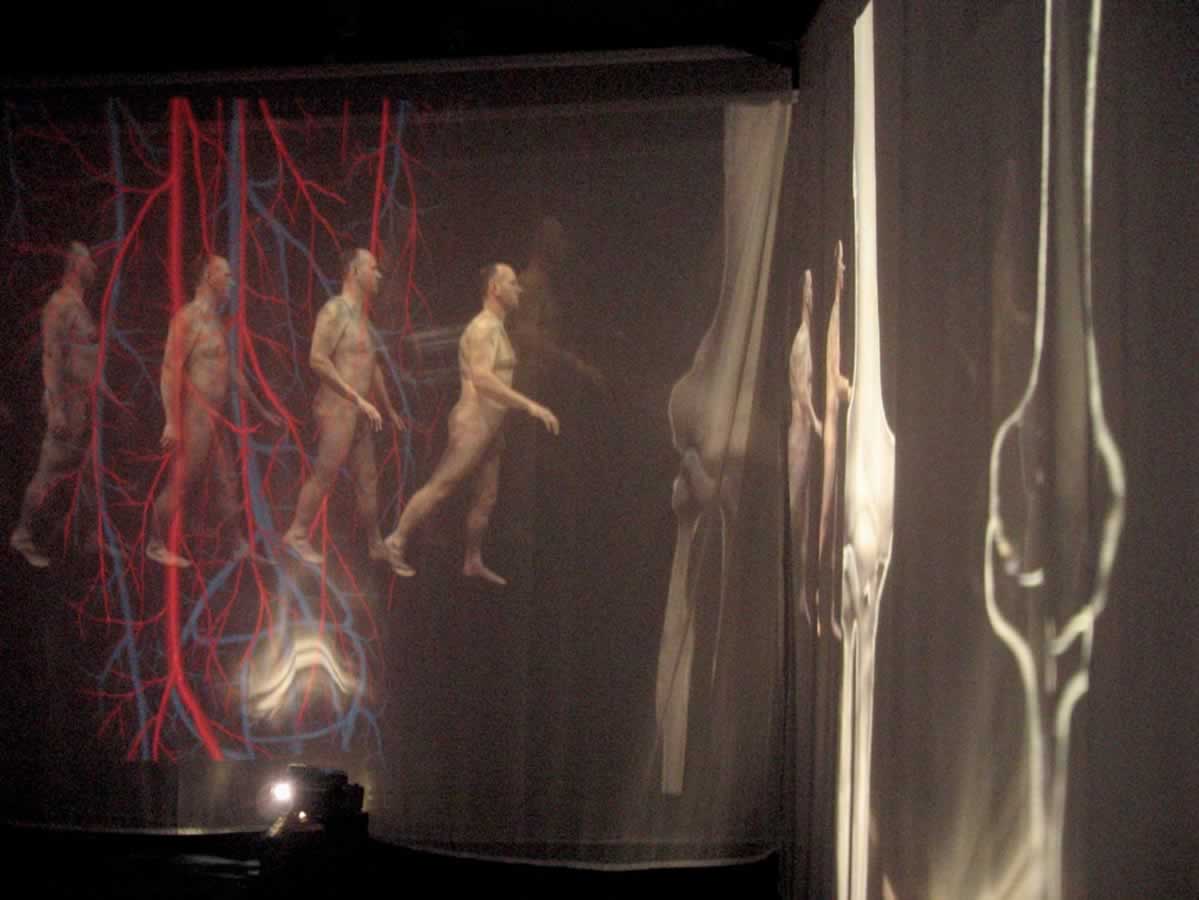
'WAWWA' 2004.Eight projector work. Image courtesy of the artist and GV Art gallery, London
The time-based journey aspect in the work is interesting because the notion of change for the viewer is very alluring. The click of the projectors as the carousel moves to the next slide is a signal of a future change of image, it is slightly Pavlovian, classical conditioning, and the viewer wants to know what happens next. It is fascinating how it lures the viewer in and it is really interesting when you have two or more works shown in adjacent spaces so there can be glimpses of one from another, you watch one for a while and the get drawn by the other in a circle of addicted engagement. You can change the viewer's expectation too in terms of scale or what something actually is. Is it macro or micro, are you at the end or the beginning of the sequence of images: have I seen this cycle of images or not, has it started again? To complicate matters you can have several cycles in a carousel.
The other bit about the projection I really like, is the way that in using two projectors directed onto a set of three screens, the viewer alternatively sees images coming from behind and in front. When projected from behind, one is looking at the image in a way 'objectively'. When the image comes from the other side of the voile screens, the image captures the person within the image and it surrounds the viewer, here it's a more 'subjective' experience. You are caught in the work; this alternating aspect is interesting in terms of engagement with the pieces. Then one can also walk between the screens having a different encounter, wafting the screens gives a 'floaty' effect; the world moves. Being between the screen, blocks the projection, casting shadows on the screens observed by other viewers.
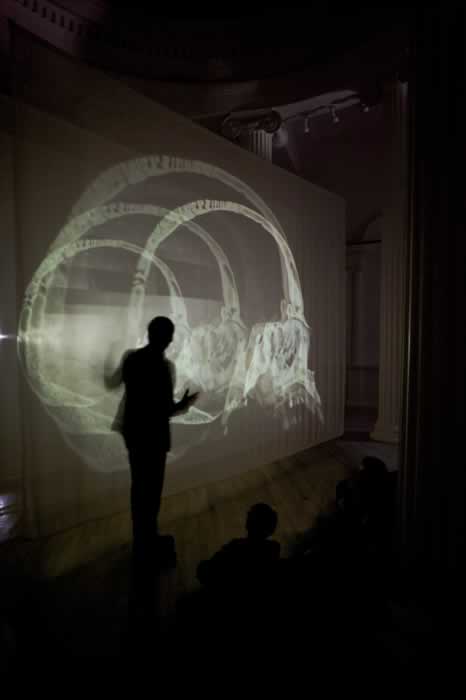
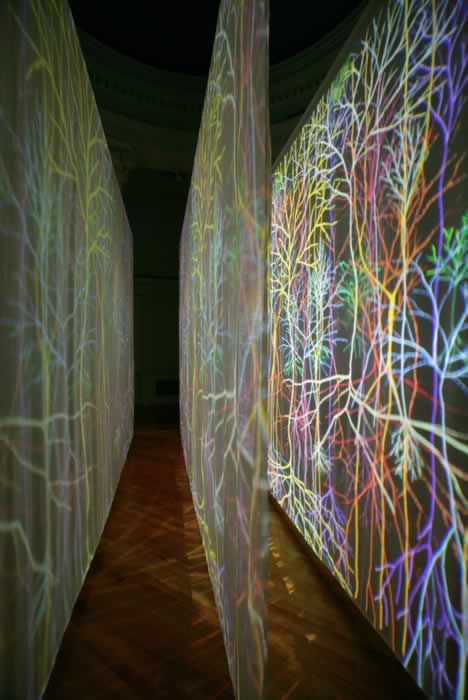
'MagicForest' Williams College Museum of Art 2010. Image courtesy of the artist and GV Art gallery, London
4. You've been working on the project, An Open Heart for a while now. Could you give us a little information about the ongoing process of this massive project?
I have used several titles to the project but I think the real one is Hybrid Bodies. Hybrid Bodies has been a long and interesting project that is for sure a big undertaking. This has been partly due to practical issues and the geographical distance between the artistic team, which includes two Canadian, and two British artists, both sets based in their respective countries and the Heart Transplant team then being based in Toronto, at the Toronto General Hospital, a few hundred miles from even where the Canadian artists live. The distance means we get together less frequently than is useful.
Then it took along time to get ethical approval in Canada for the project. We have had access to video recordings of post transplant patient interviews and this was obviously sensitive material. It took a year to get the approval! The project itself had funding for three years. The funding came from the SSHRC, Social Sciences and Humanities Research Council. This time frame was very nice as it really allowed an engagement with the work and the research; time to review and build complex work. I think I have made three video pieces and a piece that is being cast in soap in Montreal currently, A Tender Heart. Plus, I am finishing a sound sort of sculpture, well a cloth sculpture with embedded speakers, The Beat Goes On. A couple of these works will be shown at PHI in Montréal in January -February 2014. We had a test show in the Black Box at Concordia University in Montreal last summer that went very well. We are trying to get a venue in Toronto to make more of a relation with the Hospital, and we are interested in other venues across the globe if any one has an interest in it! It is a fascinating topic.
'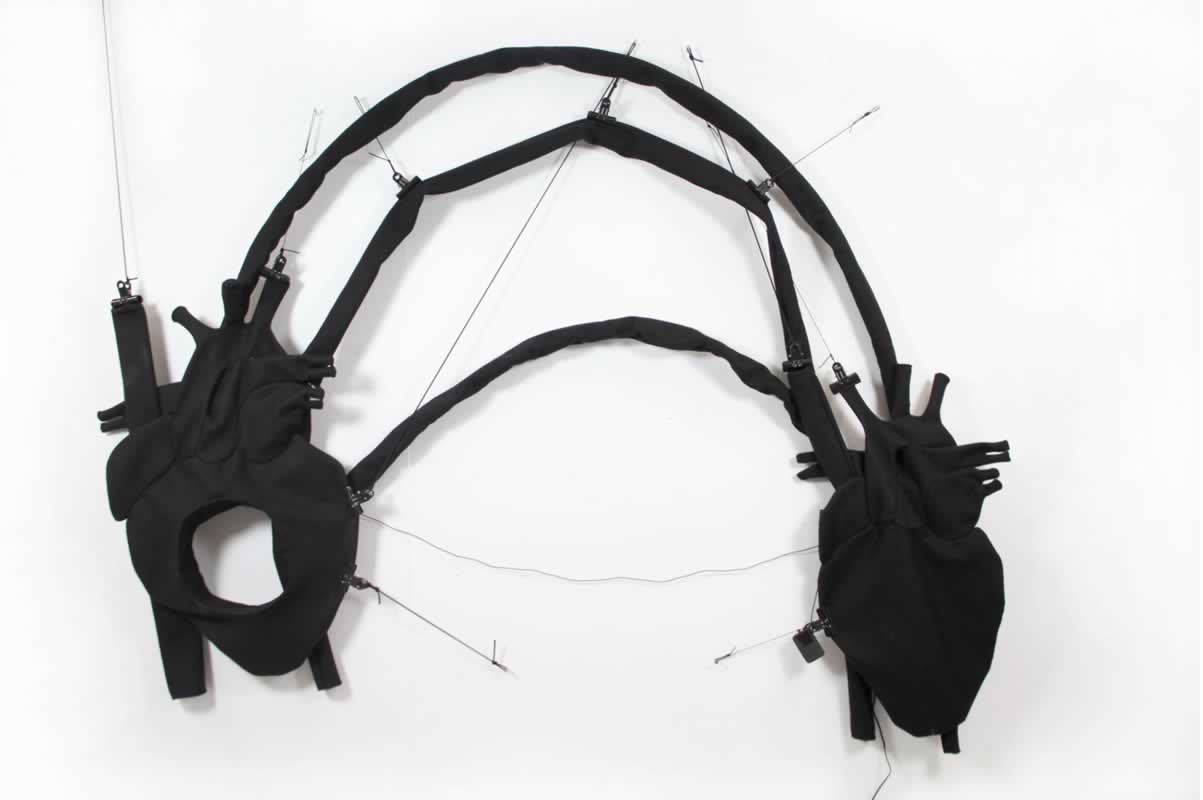
The Beat Goes On' 2013 in the studio. Image courtesy of the artist and GV Art gallery, London
My work for it centers around ideas of change and disruption to a sense of the singular, embodied self and has been mainly based around the writing and philosophy of Dr Margritt Shildrick, whose thinking I am very inspired by; she is part of the research team. The interviews have undergone analysis by her and others looking at the content of the spoken word but also an understanding of the gesture and body language of the transplantees. This all fed into my work as I rapidly made drawings while listening to the taped interviews and the 'in real time' spoken analysis of the researchers. These drawings, often based around subversions to human form, echoing the anatomical, anatomized body, have gone onto being the prototypes for images in my work, A Change of Heart 2012.

'A Change of Heart' 2012, YYZ gallery Toronto. Image courtesy of the artist and GV Art gallery, London
The project has gone very, very well and the research team, led by Dr Heather Ross would like us to be involved in a second phase. This new phase would be looking at the well being of the donor families. This is real excellent, as at the beginning of the project there was a considerable amount of, I guess, scepticism as to what use our, the artists', involvement would be to the research team. The physical art works are a real focus though and I think the first time we showed the early work at the YYZ Gallery in Toronto to some of the transplantees, this changed everything because the ensuing conversations with transplantees were so rich and revealing of the inner state of the patients. This was apparent to all involved, the artists and importantly the research team and surgeons so it made a very useful impact and made then realize they could gain from this access.
5. What are you currently working on now?
Well I am just working on finishing the soap and sound work for the Hybrid Bodies project in Canada. Just last night though saw the opening of not a new work but a new version of the work Dark Garden: Wired in A Different Way as part of the 10 Days; Creative Collisions project, in Winchester, the city I live and work in. The recent work on the piece involved adding a sound track to the slide dissolve work, a first for me. So I have been working with sound artists Steve Bayley and Matt Grover to do this. The added sound track is called Dark Garden: Heard with a Different Voice, it worked very well, so that is good and we have one more stage to go with some funding from the Arts Council England to refine the sound and add some sections we so far have been unable to complete. We have taped interviews in the sound track currently and I would possibly like to remove them, so from now on to be heard in an anti-chamber to the room Dark Garden is shown in. This would involve producing a work that the speakers would fit in. I have some dark shadowy vision of neurons hanging from the ceiling but the idea is not settled yet. The inclusion of the interviews, which were with two very prominent scientists and experts in the field of autism, Dame Uta Frith Professor of the Institute of Cognitive Neuroscience and Department of Psychology, University College London and Francesca Happe, Professor of Cognitive Neuroscience at the MRC Social, Genetic and Developmental Psychiatry Centre at the Institute of Psychiatry (King's College London) is very interesting. The interviews give a glimpse into current thinking on the subject and at moments they coalesce very nicely with imagery and what is happening visually. The interviews rise and fall in volume and pan between each speaker, interlaced together. So this is one sound track for two channels and the other channels are the sound track devised by Matt and Steve after a considerable amount of engagement with the subject of sensory difference in autism. These tracks are underpinned with another track based on an atmospheric response to sensory difference made from ideas gleaned from the interview tapes. Its complex and fitting for the original work Dark Garden: Wired in A Different Way.
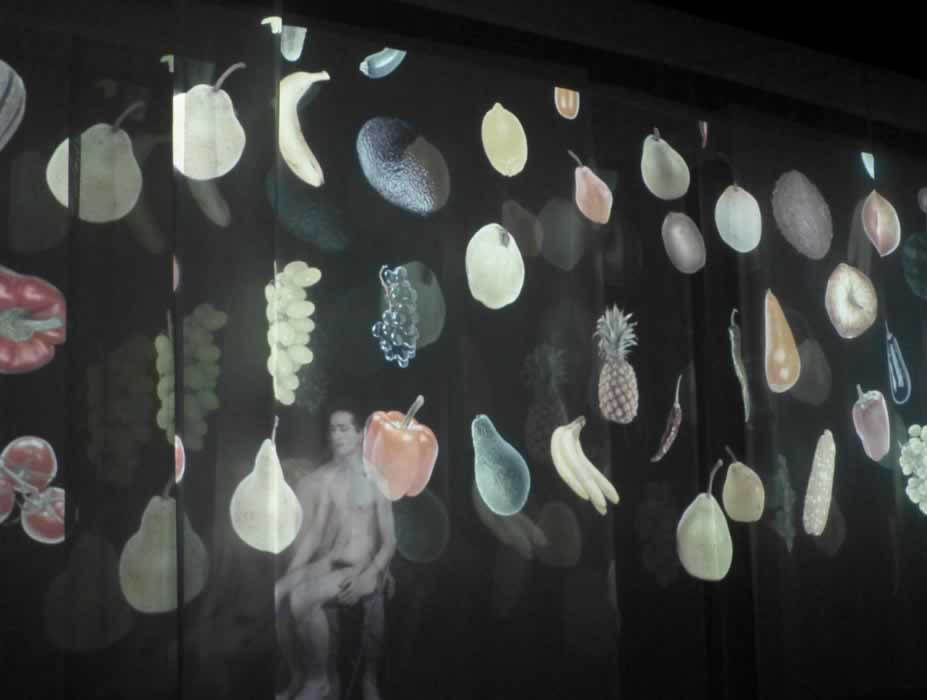
'Dark Garden: Wired in a different Way' 2012. Norwegian Science Museum Oslo. Image courtesy of the artist and GV Art gallery, London
The very next project though is working in the new scientific field of optogentics and some of the areas this technique might enlighten us about; so dementia and depression might be key areas of investigation in this project. Hopefully this work will start in the next week or two, we have a title Illuminating the Mind, for the project, that is Susan Aldworth the artist and I. We are just finalizing the contract to do this collaborative work with Global Eye Arts. Global Eye Arts have funded us both to do artsci related work before. Run by Andrew Stevenson, this type of individual funding for a project seems unique. It is something he wants to grow with more supporters coming on board to help develop the idea.
6. How do you feel the SciArt community differs between the UK and the US?
It is very, very difficult to get a handle on what is happening in any one country in terms of sciart activity unless one lives there or has someone or an organization one is close to, to get a picture of the state of matters. Much of the work seems hidden away. I have over the years picked up on quite a lot of work outside the UK in Europe, finding centers around Leiden in Holland and Berlin. The Hygiene Museum in Dresdan is also central to matters and has led the way, I believe setting an example for the Wellcome Trust in the UK. They share quite a number of exhibitions. I was very fortunate to be in the exhibition Images of the Mind, curated by Collen Schmitz (Deutsches Hygiene-Museum) and Dr. Ladislav Kesner, (Mährische Galerie Brünn). The show also toured to Brno in the Czech republic; what a show, what a cast of artists! The oldest works included mediaeval manuscripts, anatomical drawings by Leonardo da Vinci, and portraits by artists such as Lucas Cranach the Elder and Rembrandt. Other highlights included works by artists such as Max Beckmann, Max Ernst, Man Ray, Josef Beuys, Bill Viola and Antony Gormley. Not to mention the photographs, drawings and diagrams by Sigmund Freud and Nobel Prize Laureates Camillo Golgi and Ramón y Cajal as well as numerous examples of the very latest imaging methods from renowned neuroscience institutes. The Hygiene Museum in Dresden is thought to be one of the earliest galleries to show sciart work. Then more worldwide, one is also aware of the role that Symbiotica has played in Australia. A number of the artists connected with Symbiotic have shown at the the gallery that represents me. So there is an interchange with the UK through the gallery. There seems to be a lot that goes on in the UK and it is rooted within Europe and other countries.
As a lecturer in the UK, at a British University I have a good idea artsci is on the rise in the UK. We have new courses setting up in other institutions, like Westminster University, being specifically about science and art collaborations. Plus, increasingly students where I teach are coming forward saying that they have an interest in this area. The brain and research on it certainly seems to fascinate many of them. Where they quite get this I don't know, a lot of these are students independent of me, so collaborations and art and science are in the air.
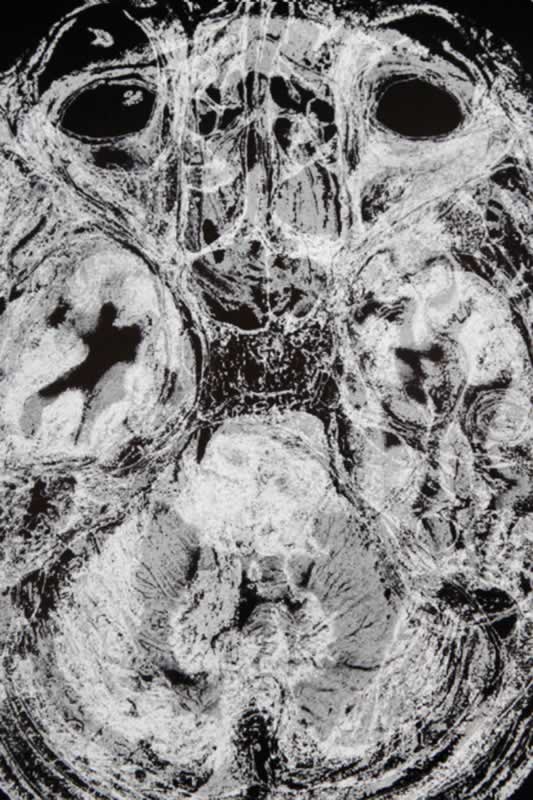
'Atlas: There and Here' 2012. Video work for Brains: Mind s Matter Exhibition, Wellcome Trust Building. Image courtesy of the artist and GV Art gallery, London
The art gallery where I exhibit in London gets a stream of enquiries about work in this realm and staff in scientific institutions are familiar with the idea of sciart residencies. The Wellocme Trust, who are massive providers of scientific grants positively like applications that include some form of dissemination of research work through art. Kings College London is developing its own center, the Science Gallery, near Tower Bridge with Dr Dan Glaser at its helm, based on science and artwork to promote research that takes place within the university. So in the UK matters are really taking off. Contrary to this, is the situation in Canada, where the Hybrid Bodies project is based, the notion of this type of work is uncommon and a lot of international students coming to our university, Southampton are amazed that these sorts of practices happen.
In the USA speaking to American artists, I feel they are frustrated at the lack of funding available to pursue such routes to making work. I think we are lucky in the UK that these various funding streams are available, the Wellcome Trust, the Calouste Gulbenkian Foundation, the Arts Council England, the Leverhulme Trust; so we are fortunate. Even with these funders competition is stiff and despite putting in I think very good proposals for fairly large sums of money lately, I have had no success.
I think in the USA there are many individuals making work in this way, artsci, sciart, and have been for a longtime, but often they are making work in isolation; known only to a small group of people. I first showed in the USA with Susan Anker of SVA New York in 2007 then at Exit Art in 2008. Then it seemed there was not a lot going on but trawling the web in latter years made one realize there were quite a lot of individuals making work across the States and some interesting conferences happening on the topic. Funding has always seemed to be difficult in the States. Of course then somehow I discovered ASCI and Cynthia Pannucci and you do suddenly realize there is a lot going on across all of America and for a considerable time. Somehow, like in many places this kind of work has been marginalized, maybe galleries selling singular often male 'genius' artist have thwarted this type of work; the notion of collaborative practice is likely to be an anathema to the structure of existing galleries and their economic system that puts primacy on the object of original genius.
Matters seemed to have moved on in the USA very quickly and it was interesting to see the growth of exhibitions in the USA since the first visit with Magic Forest in 2007. It slightly annoyed me because we had good foundations here in the UK but some of it seemed to go slow here and I was always frustrated that Art and Mind, directed by Garry Kennard did not get more support for the early festivals which he had started, were quite excellent, running from 2004 to 2009; incidentally and quite coincidently in my home town, Winchester. What a joy to find when I first moved there in 2004. I soon joined the trustees of the organization. Garry still continues with fascinating events but they are somewhat scaled down with seminars and speakers on specific topics, GV Art and Mind symposiums, happening at the GV Art gallery London about every three months, incidentally where I exhibit. The first Art and Mind event was stunning with such luminaries as Vilayanur Ramachandran, Antony Gormley, and Richard Gregory speaking. GV Art gallery has been very good as a focus in the UK for science and artwork and is one of the only galleries really focusing on this area and I am lucky that they support my work.
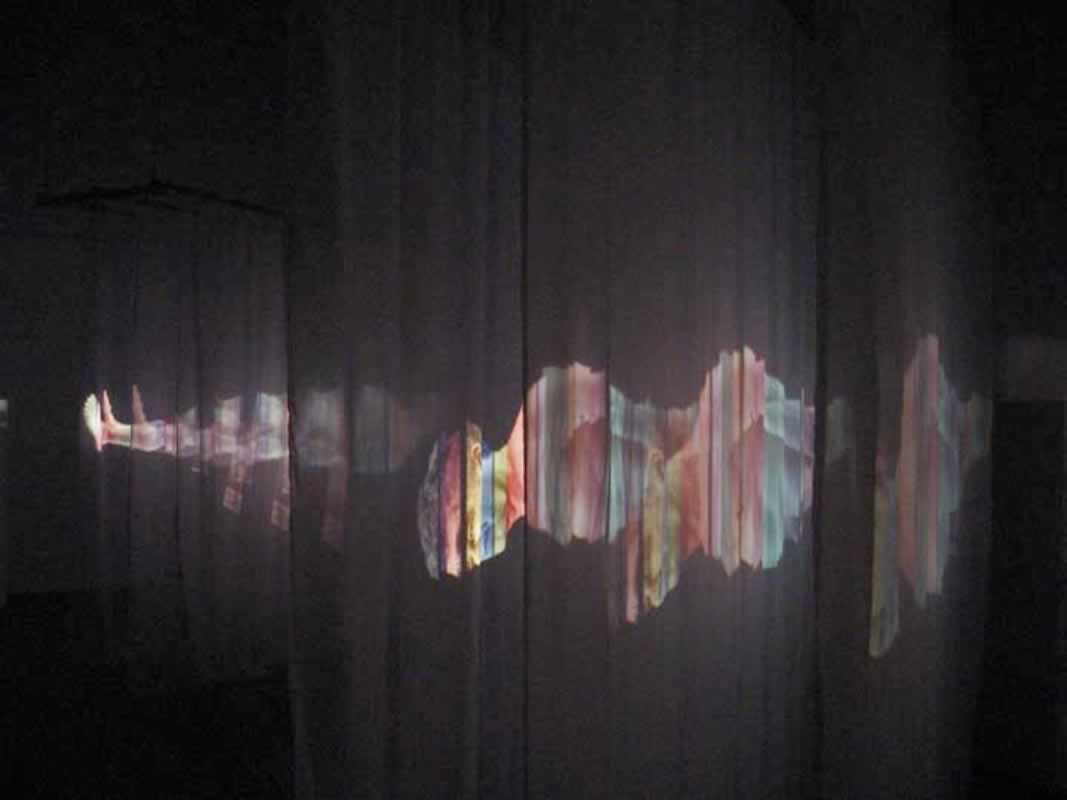
'Fray: Coming Away at the Ends' 2010. For the Great North Museum, Newcastle. Image courtesy of the artist and GV Art gallery, London
So trying to sum up on this matter, probably there are a lot of artists working in the area both in the USA and UK. Artists are probably better financed in the UK and the scientists are warm to the idea of their participation. I heard a story a couple of days ago from a scientist that is interesting. He was working at a synchrocyclotron in the UK at Harwell, where there have been a number of artists' residencies but he said he had been to similar facilities in the USA and the public didn't even know the synchrocyclotron existed, never mind have artists inside.
7. What sort of partnerships/residencies have you been in, in the past? What came out of those?
Are you in any currently? Well I am working on the project in Canada around heart transplants, Hybrid Bodies that comes to fruition in January 2014 at the PHI gallery in Montreal and I am also just starting a project funded by Global Eye Arts and Andrew Stevenson with the artist Susan Aldworth. Previously, I have been in lots of 'relationships' with scientists. They have varied greatly as to my depth of involvement. The connection with Richard Wingate has been the longest one, we were involved over quite a period developing Magic Forest and then Complex Brain: Spreading Arbor. As the projects went on there was a greater exchange of ideas and involvement. At first it was in a sense just looking over Richard's shoulder at the science, latterly we have both been much more involved. Ultimately in all projects it has been me that has gone away and made the artwork: that is my field of expertise. Most recently I worked with Richard along with Karen Ingham, Susan Aldworth and Marius Kwint in putting the Between: embodiment & identity exhibition together for the Somerset House Gallery, the Inigo Rooms in London. The exhibition explored how personal identity has become embodied in a powerful landscape of anatomical imagery. I showed Seized: Out of this World for the exhibition with some drawings, this was the most fitting work to the content of the show, embodiment.

'Seized Out of This World' 2009. Image courtesy of the artist and GV Art gallery, London
During the ten or so projects I have done over the years, contact with scientists has been long, concentrated and involved or short and brief, just getting some directions for further reading. The same is true for contact with patients or sufferers that have been involved via a project. Sometimes there is quite a lot of contact for a project and sometimes not. It has depended on circumstances and availability. In some way it is core ideas I am after, so the contact does not need to be that great. I wonder also how much one can get from any one lab or scientist without matters getting a bit stale, and not having fresh material to put into a work. Some sessions have been a bit short too, due to the grants coming on stream too late and the exhibition dates coming up too soon. The Hybrid Bodies project has been just great at three years in length.
What I am really interested in, is developing larger collaborative groups to work with and having more 'triangulation' of the work. Marius Kwint, a cultural historian and Richard, a neuro-scientist and I have worked on a number of projects and applications together. This three-way approach is really interesting in how it brings knowledge of the current science together with a historical - cultural perspective and the fusion with the artwork. This I feel is a real way forward and somewhat forsees a future methodology. I wish we could also involve the fascinating anthropologist Natasha Myers, of York University Toronto, in a further four-way cooperation. Natasha's ethnographic research examines forms of life in the contemporary arts and sciences. Her insights into how artists and scientists work are fascinating and I look forward to reading her forthcoming book Rendering Life Molecular. The book explores the laboratory entanglements of the protein crystallographers and biological engineers, who are reconfiguring the materialities and imaginaries of the stuff of life in the twenty first century. She has also worked on how artists work in the studio and science lab.
8. Do you foresee anything in the future for SciArt?
I think art has to have content, and I feel this type of practice will grow and continue, maybe there will be the funding to allow more integrated and fully symbiotic work as framed by Arthur I Millar. I am not sure individuals can make remarkable art and undertake remarkable research but I am sure teams of artists and scientists could. I am sure that there ways of thinking that artists have that could be harnessed better in science labs and elsewhere.
One element we should aim to get right in society is the employment of artists. I think they are very underutilized in the developed world. We train many, many artists, they are enthusiastic for their work eager to communicate, they are 'Thinking Aloud' as the sculptor Richard Wentworth might say with their work but they have a marginalized place in society. We should use artists as with philosophers to enlighten every corner of our activity. What a waste to train so many artists as in the UK and not allow them to practice anywhere; only allow a few to inhabit the art market place. The old order of genius and the masterpiece is somewhat dead and arcane.
I think very strongly artists should be part of scientific communities but importantly more widely through every aspect of society, questioning proposing, transplanting and translating what ever they want to do, in such situations. They should be free to roam and bite back, even bite the hand that feeds them from time to time. I think sciart, artsci, artists working with scientific ideas is important, but really it is just art and artists finding content, and content should be part of all artists work; work should spawn a dialogue.
An important reason in having sciart artsci continue and go from strength to strength is its role in interpretation of scientific data. Data from science should not just be left to science or science communicators to disseminate. It must be open to different interpretation and artists are well suited to this role; placing ideas and moral dilemmas into the human sphere.
So I would hope there is further integration, our society should reflect us as we are blends of many elements; thoughts are rational and irrational, cool and emotional, art and science. A rounded being has an eye for everything and a healthy society should have the arts and artists rubbing shoulders at the least with the scientists; what we need to do is make more opportunities for this to happen.
Simply more 'homes' for artists I say, in many, many different communities including science labs.
Books containing writing on the work.
interview on the work by Jack Chuter
andrew carnie cv.
andrew carnie satchi web site link
| about us | site map | privacy policy | finding the studio | catalogue | contact us | finding city road winchester |
© 2010 Carnie Art Services